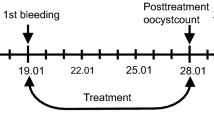A yellow-faced vulture includes ungulate faeces in its diet for cosmetic purposes.
Abstract
The rare Egyptian vulture (Neophron percnopterus) stands out among the Old World vultures (Family Accipitridae) because of its brightly ornamented head1, which is coloured yellow by carotenoid pigments, and its practice of feeding on faeces. Here we show that Egyptian vultures obtain these pigments from the excrement of ungulates. To our knowledge, this is the first demonstration that faeces can be used as a source of carotenoids by a vertebrate.
This is a preview of subscription content, access via your institution
Access options
Subscribe to this journal
Receive 51 print issues and online access
$199.00 per year
only $3.90 per issue
Buy this article
- Purchase on Springer Link
- Instant access to full article PDF
Prices may be subject to local taxes which are calculated during checkout


Similar content being viewed by others
References
Mundy, P., Butchart, D., Ledger, J. & Piper, S. The Vultures of Africa (Academic, London, 1992).
Hurd, P. L., Weatherhead, P. J. & McRae, S. B. Behav. Ecol. 2, 69–76 (1991).
Hutchings, M. R., Gordon, I. J., Kyriazakis, I. & Jackson, F. Anim. Behav. 62, 955–964 (2001).
Brush, A. H. FASEB J. 4, 2969–2977 (1990).
Britton, G. FASEB J. 9, 1551–1558 (1995).
Mínguez-Mosquera, M. I. & Hornero-Méndez, D. J. Agric. Food Chem. 41, 1616–1620 (1993).
Vogel, A. I. Elementary Practical Organic Chemistry (Logmans, Green & Co., London, 1957).
Negro, J. J., Tella, J. L., Blanco, G., Forero, M. G. & Garrido-Fernández, J. Physiol. Biochem. Zool. 73, 97–101 (2000).
Hill, G. E. Nature 350, 337–339 (1991).
Rohwer, S. A. Evolution 29, 593–610 (1975).
Zahavi, A. & Zahavi, A. The Handicap Principle (Oxford Univ. Press, Oxford, 1997).
Tella, J. L. et al. Physiol. Zool. 71, 708–711 (1998).
Díaz-Delgado, R. & Pons, X. Forest Ecol. Manag. 147, 67–74 (2001).
Author information
Authors and Affiliations
Corresponding author
Ethics declarations
Competing interests
The authors declare no competing financial interests.
Rights and permissions
About this article
Cite this article
Negro, J., Grande, J., Tella, J. et al. An unusual source of essential carotenoids. Nature 416, 807–808 (2002). https://doi.org/10.1038/416807a
Issue Date:
DOI: https://doi.org/10.1038/416807a
This article is cited by
-
Trace elements and heavy metals in black vultures (Coragyps atratus) and turkey vultures (Cathartes aura) in the southeastern United States
Environmental Science and Pollution Research (2024)
-
Heterospecific coprophagy of Coragyps atratus (Cathartiformes: Cathartidae) with Jabiru mycteria (Ciconiiformes: Ciconiidae) in Curvelo, Minas Gerais, Brazil
Ornithology Research (2023)
-
Adult poison frogs can capture and consume aquatic tadpoles
Evolutionary Ecology (2023)
-
Urban Magpies Frequently Feed on Coyote Scats and May Spread an Emerging Zoonotic Tapeworm
EcoHealth (2023)
-
Winter movement patterns of a globally endangered avian scavenger in south-western Europe
Scientific Reports (2020)
Comments
By submitting a comment you agree to abide by our Terms and Community Guidelines. If you find something abusive or that does not comply with our terms or guidelines please flag it as inappropriate.



